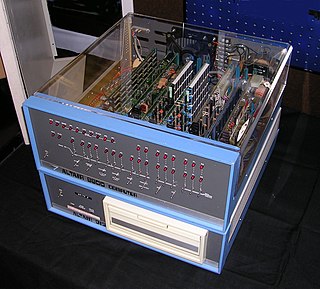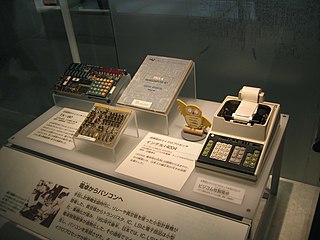Related Research Articles
Kermit is a computer file transfer/management protocol and a set of communications software tools primarily used in the early years of personal computing in the 1980s. It provides a consistent approach to file transfer, terminal emulation, script programming, and character set conversion across many different computer hardware and operating system platforms.
Stanley Bootle, known as Stan Kelly-Bootle, was a British author, academic, singer-songwriter and computer scientist.

The Altair 8800 is a microcomputer designed in 1974 by MITS and based on the Intel 8080 CPU. Interest grew quickly after it was featured on the cover of the January 1975 issue of Popular Electronics and was sold by mail order through advertisements there, in Radio-Electronics, and in other hobbyist magazines. The Altair is widely recognized as the spark that ignited the microcomputer revolution as the first commercially successful personal computer. The computer bus designed for the Altair was to become a de facto standard in the form of the S-100 bus, and the first programming language for the machine was Microsoft's founding product, Altair BASIC.

A library catalog is a register of all bibliographic items found in a library or group of libraries, such as a network of libraries at several locations. A catalog for a group of libraries is also called a union catalog. A bibliographic item can be any information entity that is considered library material, or a group of library materials, or linked from the catalog as far as it is relevant to the catalog and to the users (patrons) of the library.

Leopoldstadt is the 2nd municipal District of Vienna in Austria. There are 103,233 inhabitants over 19.27 km2 (7 sq mi). It is situated in the heart of the city and, together with Brigittenau, forms a large island surrounded by the Danube Canal and, to the north, the Danube. It is named after Leopold I, Holy Roman Emperor. Due to its relatively high percentage of Jewish inhabitants, Leopoldstadt gained the nickname Mazzesinsel. This context was a significant aspect for the district twinning with the New York City borough Brooklyn in 2007.

Thomas Alan Shippey is a British scholar and retired professor of Middle and Old English literature, as well as medievalism and modern fantasy and science fiction. In particular he is widely considered one of the world's leading academic scholars on the works of J. R. R. Tolkien about whom he has written several books and many scholarly papers.

Roy William Thomas Jr. is an American comic book writer and editor, who was Stan Lee's first successor as editor-in-chief of Marvel Comics. He is possibly best known for introducing the pulp magazine hero Conan the Barbarian to American comics, with a series that added to the storyline of Robert E. Howard's character and helped launch a sword and sorcery trend in comics. Thomas is also known for his championing of Golden Age comic-book heroes – particularly the 1940s superhero team the Justice Society of America – and for lengthy writing stints on Marvel's X-Men and The Avengers, and DC Comics' All-Star Squadron, among other titles.

Steven Levy is an American journalist who has written several books on computers, technology, cryptography, the internet, cybersecurity, and privacy.

Richard Veitch is an American comics artist and writer who has worked in mainstream, underground, and alternative comics.

The Free Dictionary is an American online dictionary and encyclopedia that gathers information from a variety of sources.

Busicom was a Japanese company that owned the rights to Intel's first microprocessor, the Intel 4004, which they created in partnership with Intel in 1970.

Stephen R. Bissette is an American comics artist, editor, and publisher with a focus on the horror genre. He is known for working with writer Alan Moore and inker John Totleben on the DC Comics series Swamp Thing in the 1980s.

Richard Bache Ayers was an American comic book artist and cartoonist best known for his work as one of Jack Kirby's inkers during the late-1950s and 1960s period known as the Silver Age of Comics, including on some of the earliest issues of Marvel Comics' The Fantastic Four. He is the signature penciler of Marvel's World War II comic Sgt. Fury and his Howling Commandos, drawing it for a 10-year run, and he co-created Magazine Enterprises' 1950s Western-horror character the Ghost Rider, a version of which he would draw for Marvel in the 1960s.
John Thomas Totleben is an American illustrator working mostly in comic books.

Robert J. "RJ" Mical is an American computer programmer and hardware designer who has primarily worked in video games. He is best known for creating the user interface, Intuition, for Commodore's Amiga personal computer (1985), contributing to the design of the Amiga hardware, and co-designing, with Dave Needle, the Atari Lynx color handheld (1989) and the 3DO Interactive Multiplayer (1993).

"The Real Thing" is a short story by Henry James, first syndicated by S. S. McClure in multiple American newspapers and then published in the British publication Black and White in April 1892 and the following year as the title story in the collection, The Real Thing and Other Stories published by Macmillan. This story, often read as a parable, plays with the reality-illusion dichotomy that fascinated James, especially in the later stages of his career. For the illustrator who narrates the story, the genuine article proves all too useless for his commercial purposes. The story portrays the unfortunate victims of a society in which reality and representation are closely intertwined in ways that make art a difficult project to disentangle the two.

Joseph Nechvatal is an American post-conceptual digital artist and art theoretician who creates computer-assisted paintings and computer animations, often using custom-created computer viruses.

Mark Podwal is an artist, author, filmmaker and physician. He may have been best known initially for his drawings on The New York Times Op-Ed page. In addition, he is the author and illustrator of numerous books. Most of these works — Podwal's own as well as those he has illustrated for others— typically focus on Jewish legend, history and tradition. His art is represented in the collections of the Metropolitan Museum of Art, the Victoria and Albert Museum, the Israel Museum, the National Gallery of Prague, the Jewish Museum Berlin, the Jewish Museum Vienna, the Jewish Museum in Prague, the Jewish Museum (Manhattan), among many other venues.

Cromemco's Dazzler is a graphics card for S-100 bus computers. Released in 1976, it is the first commercial color bit-mapped graphics card available for microcomputers. Multiple Dazzler cards could be installed in a single machine and synced together, a feature which could, with minor modification, be used to genlock. Genlocked Dazzler cards drove ColorGraphics Weather Systems displays that generated most of the weather imagery seen on US television in the early 1980s.

The TMS1000 is a family of microcontrollers introduced by Texas Instruments in 1974.
References
- ↑ Augarten 1984.
- ↑ Letters, 'Columbia Magazine, Winter 2007/8
- ↑ LibraryThing
Sources
- Augarten, Stan (1984). Bit by Bit: An Illustrated History of Computers . New York: Ticknor & Fields. ISBN 978-0899193021.